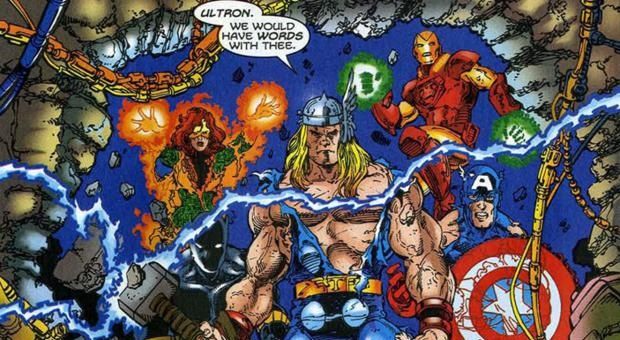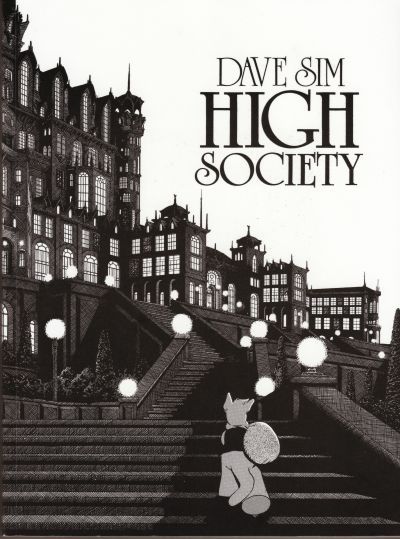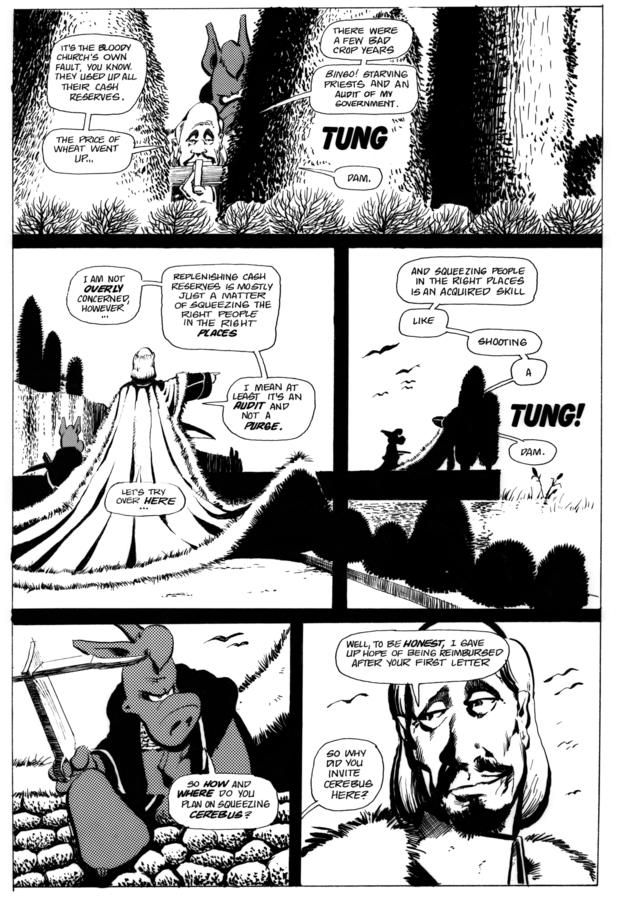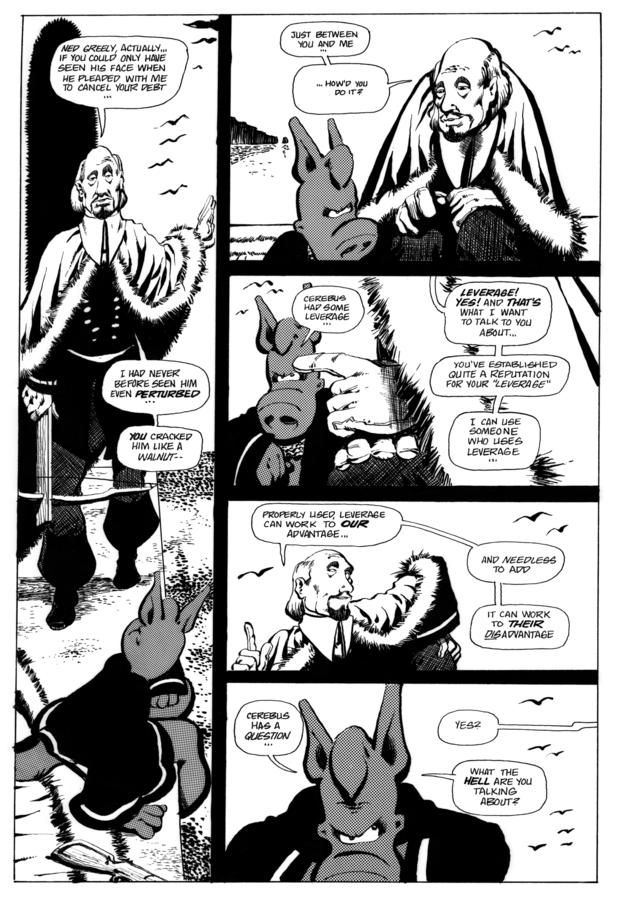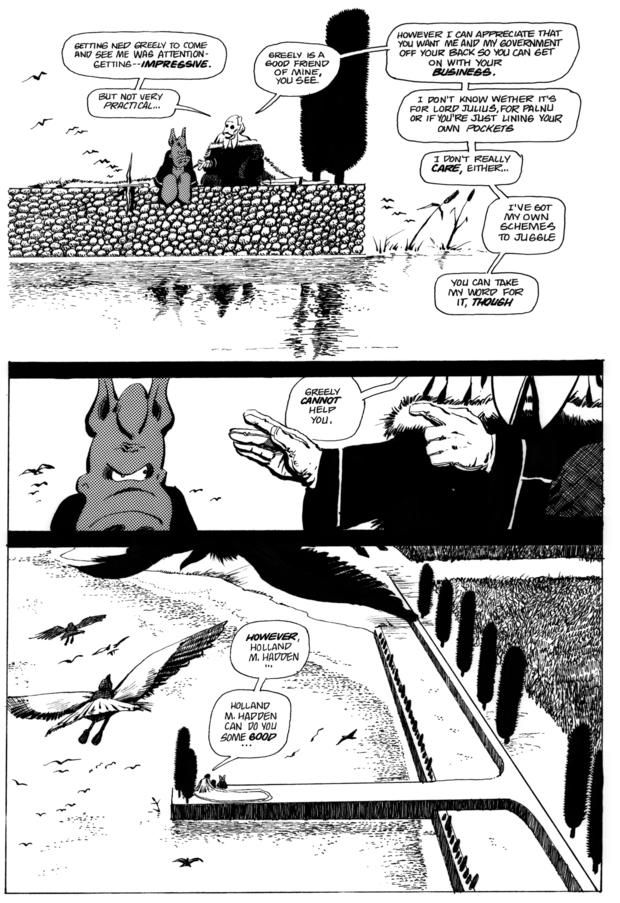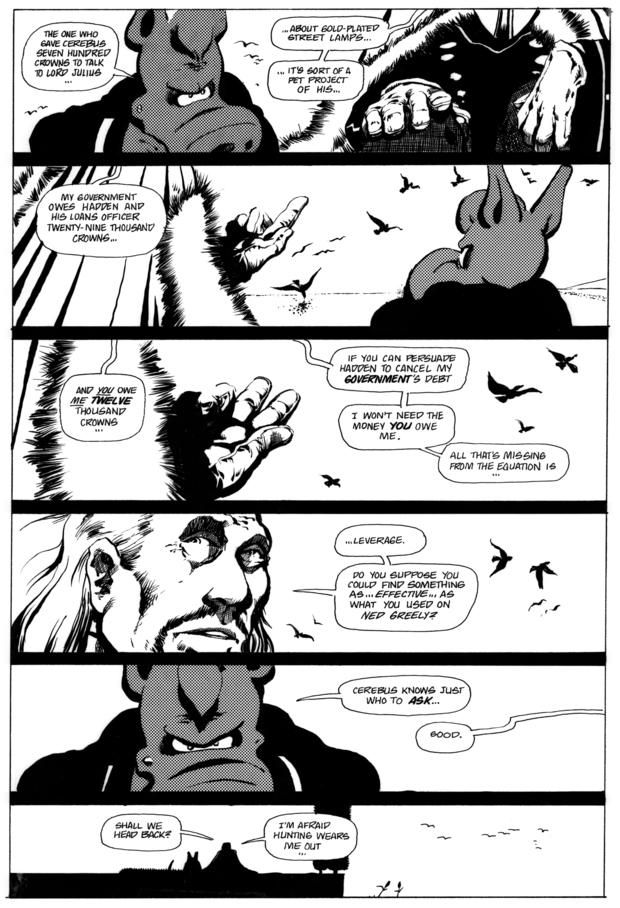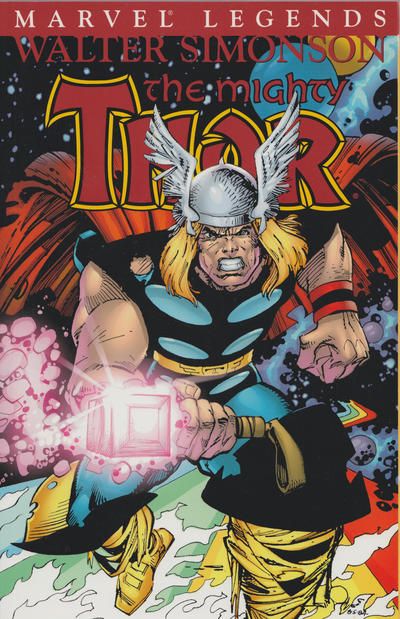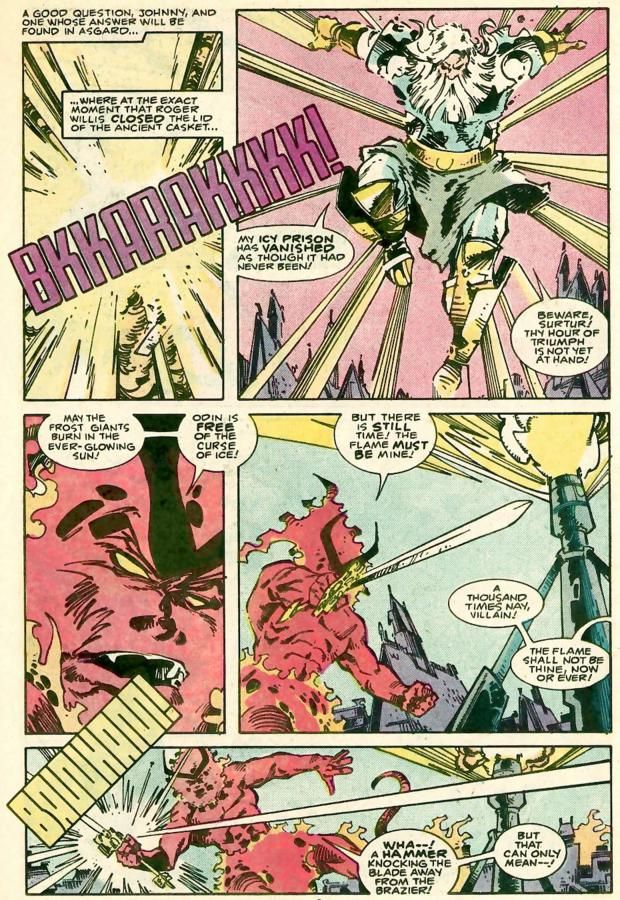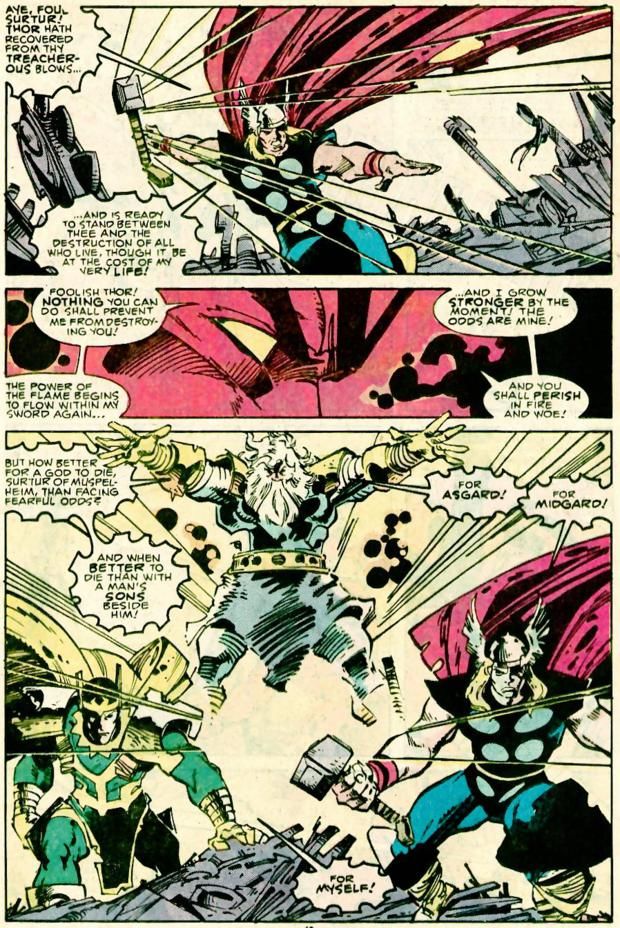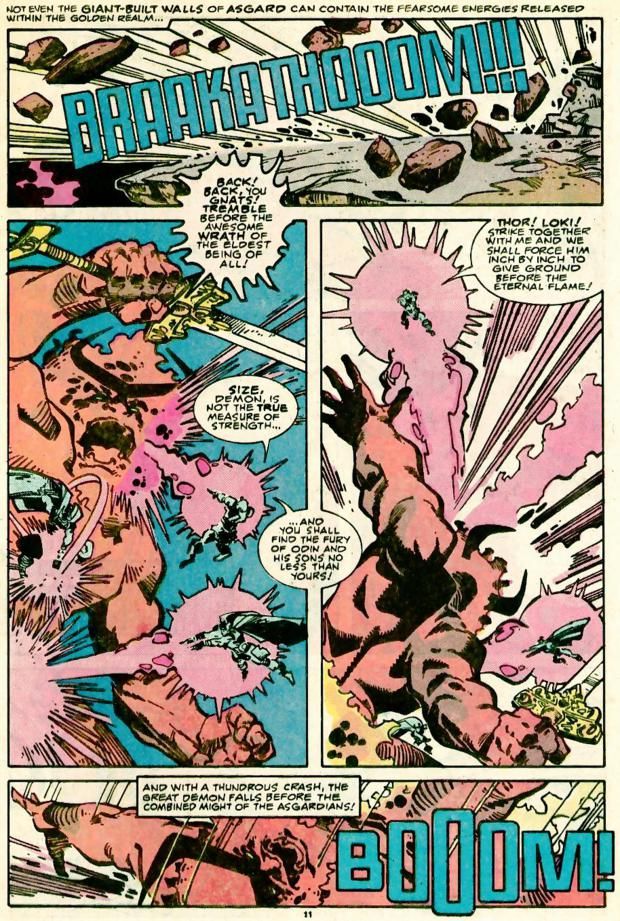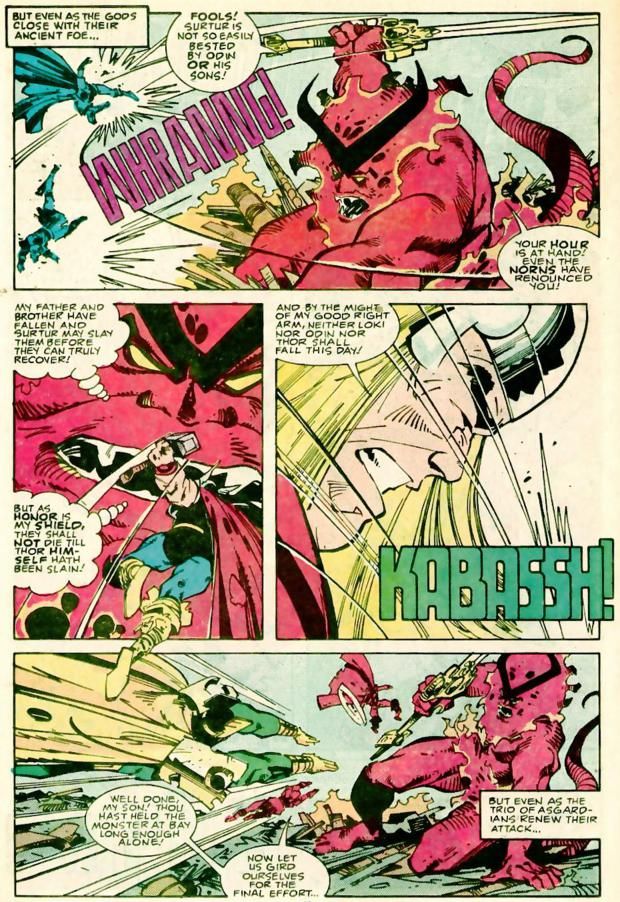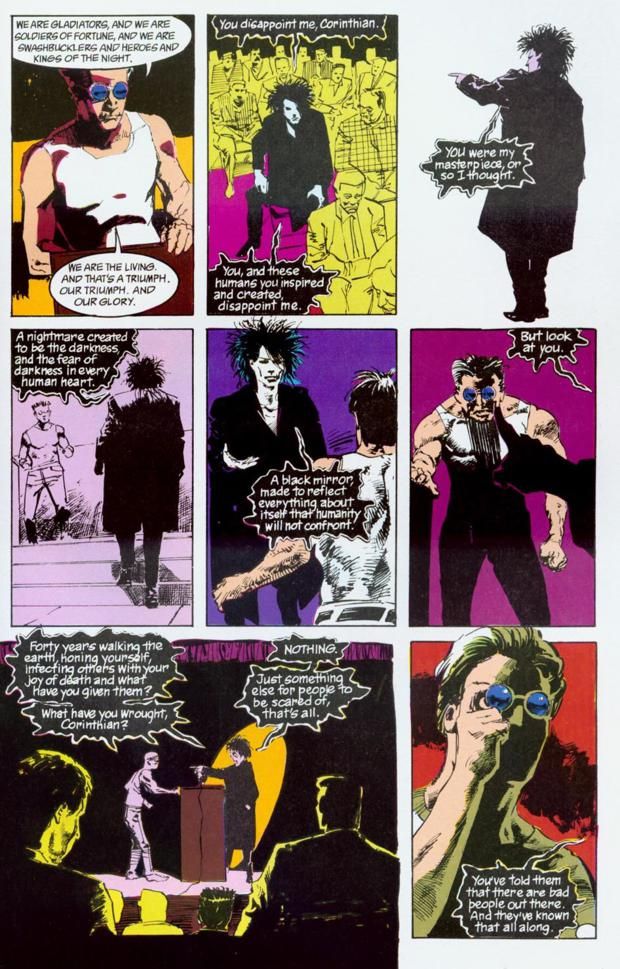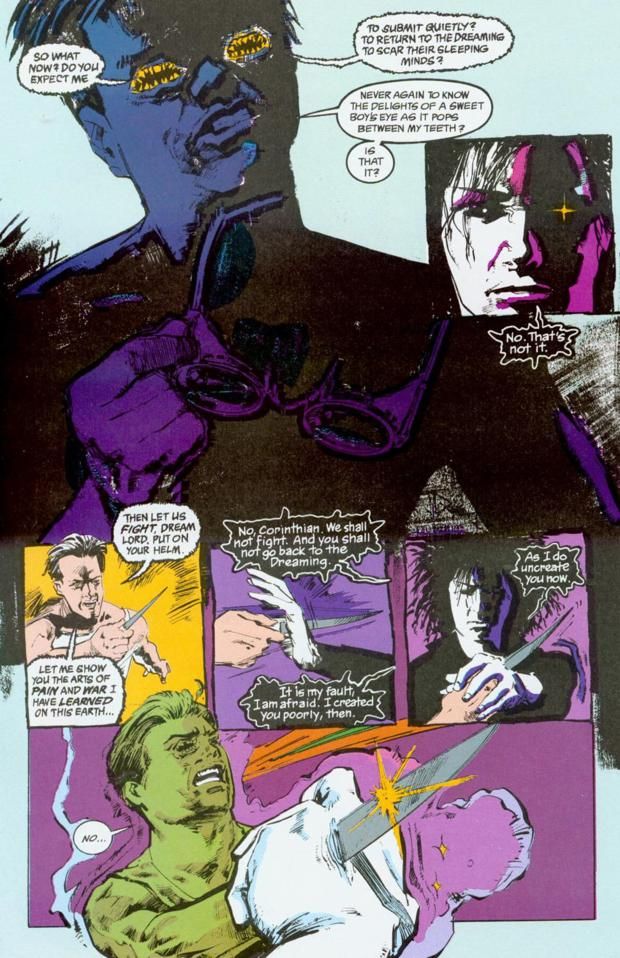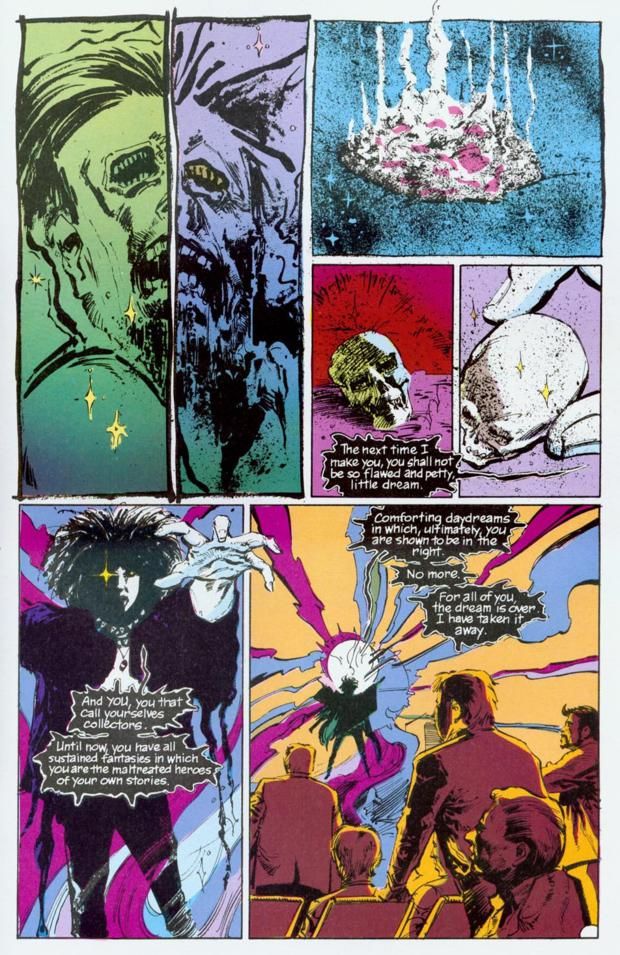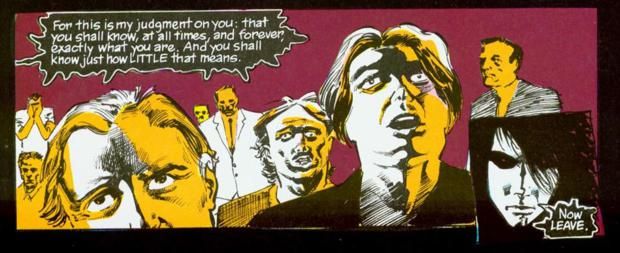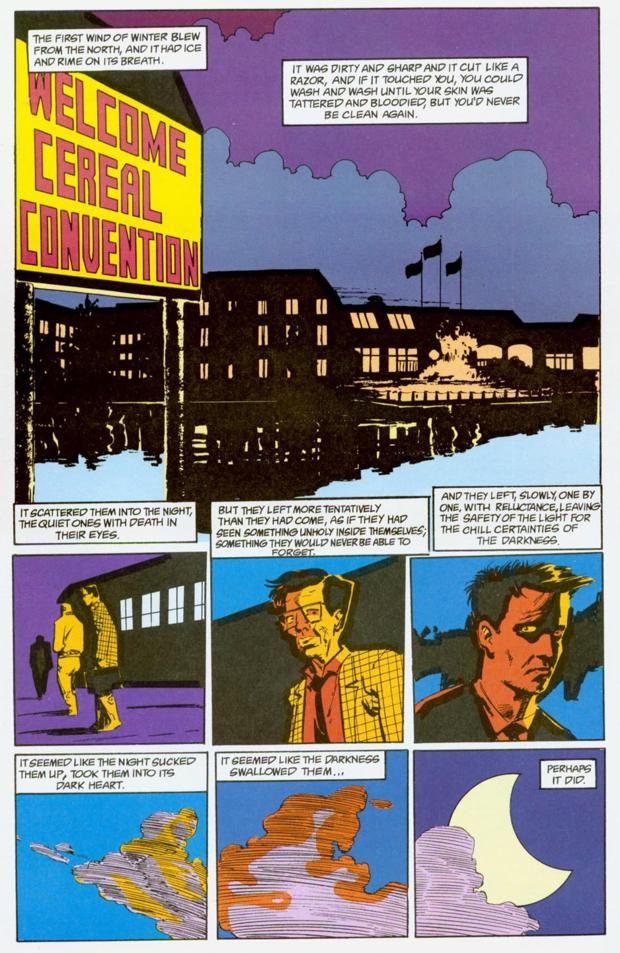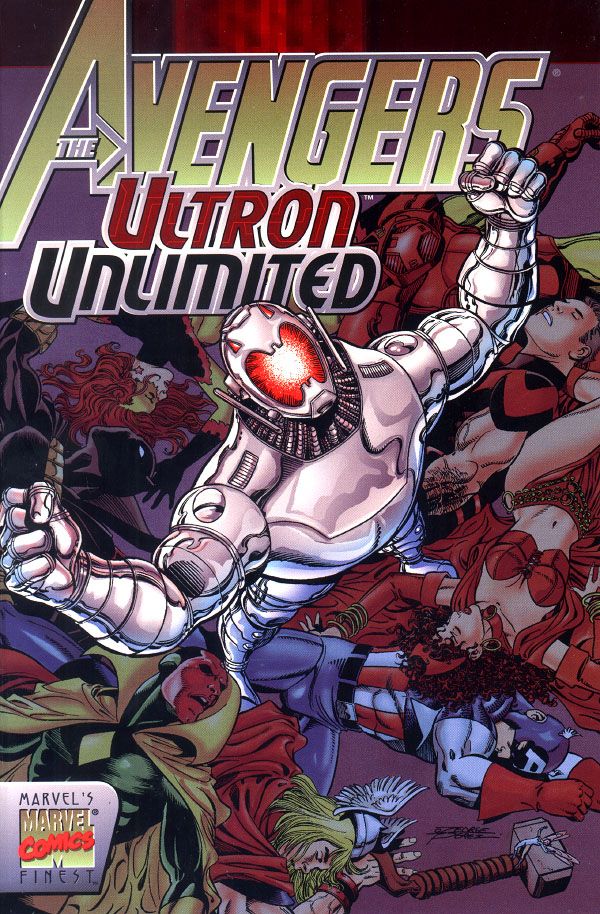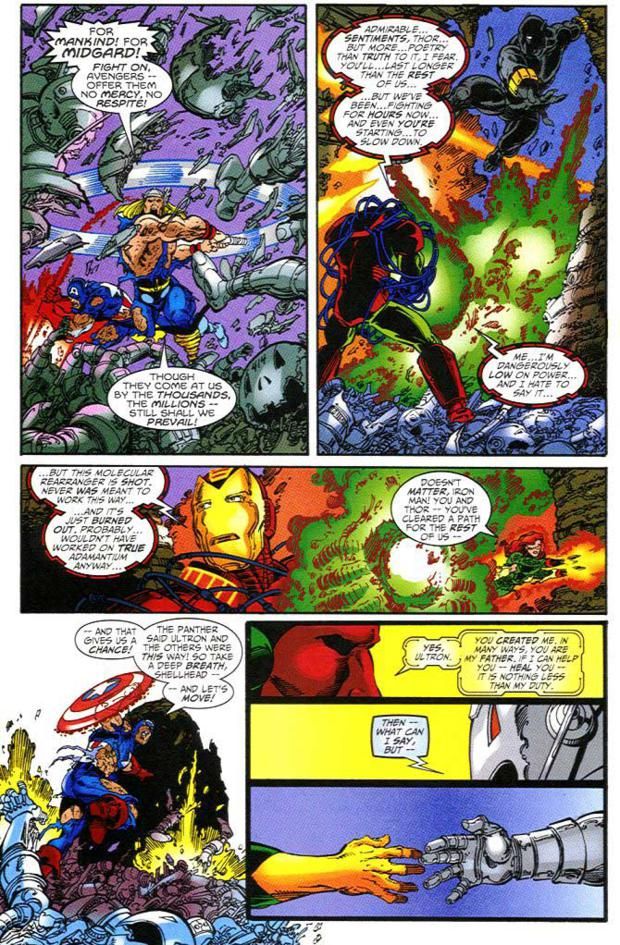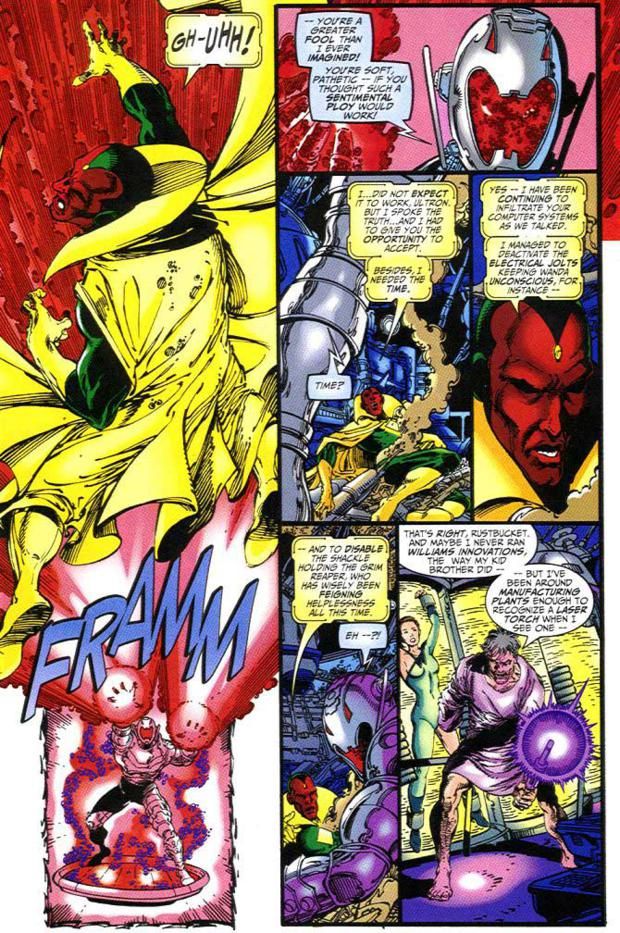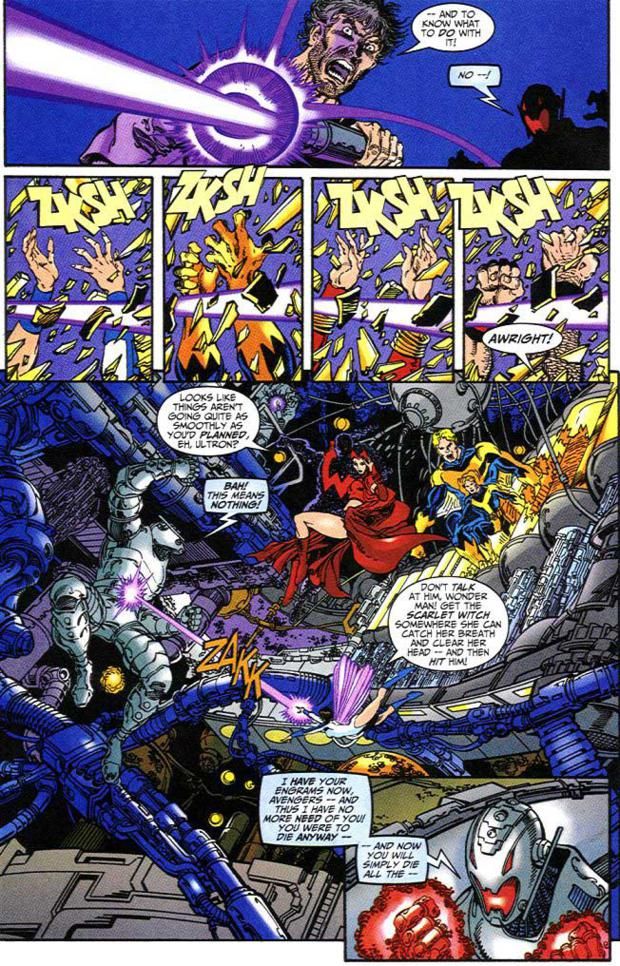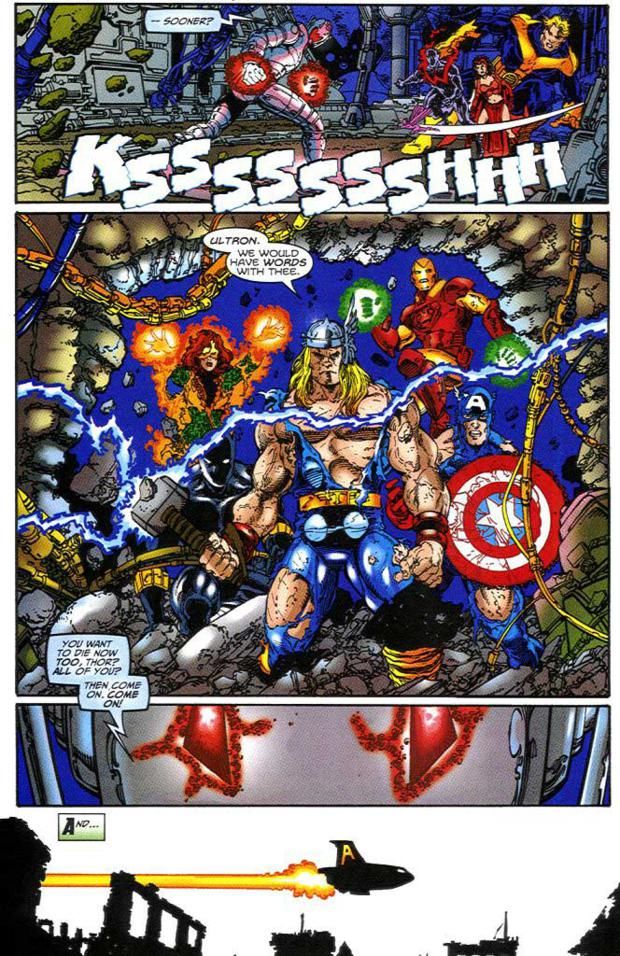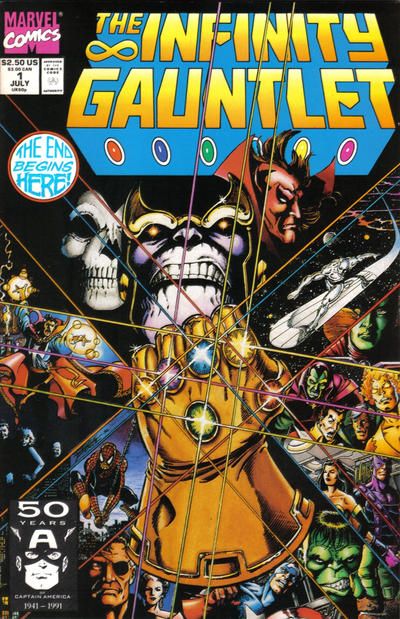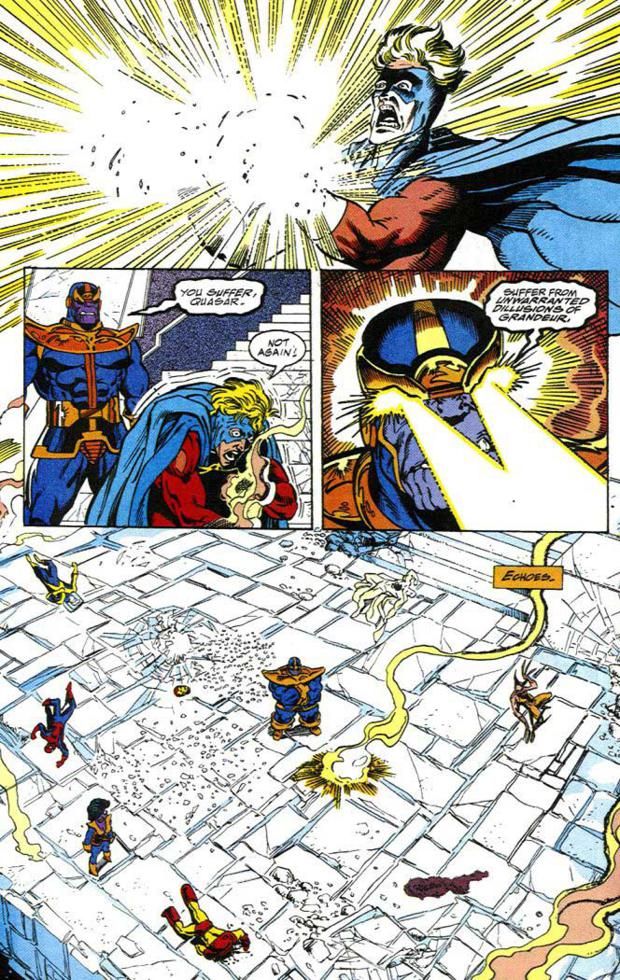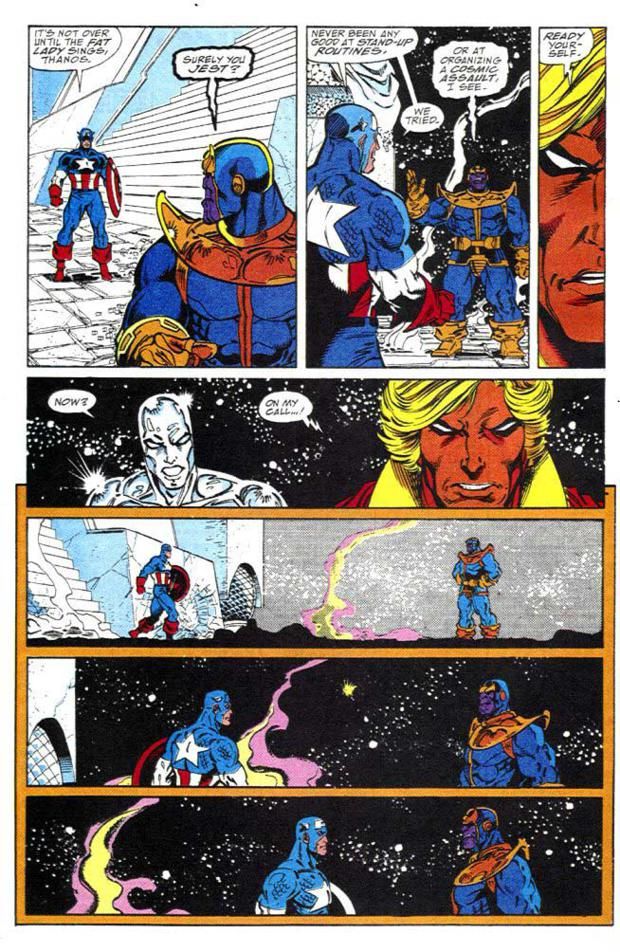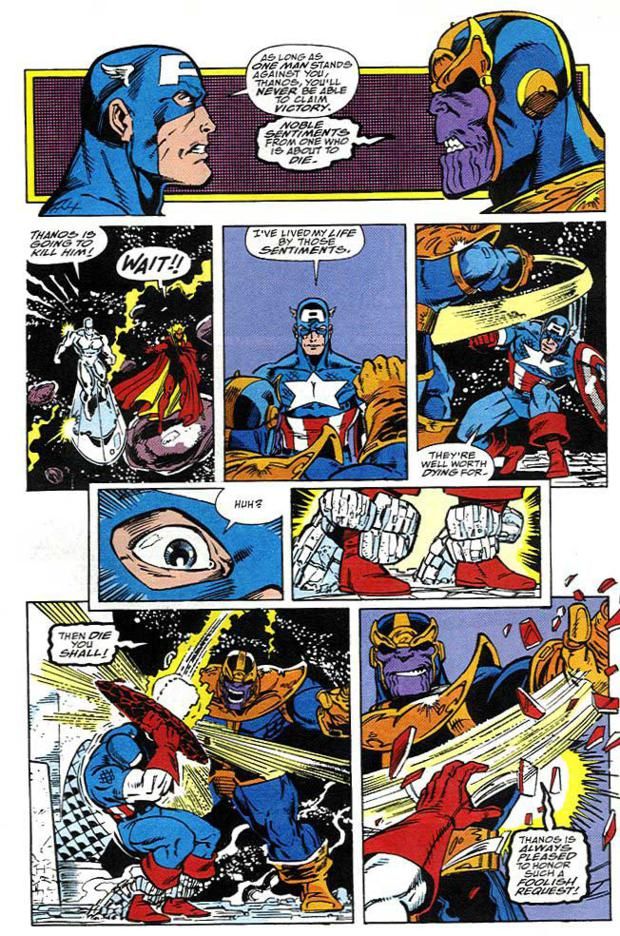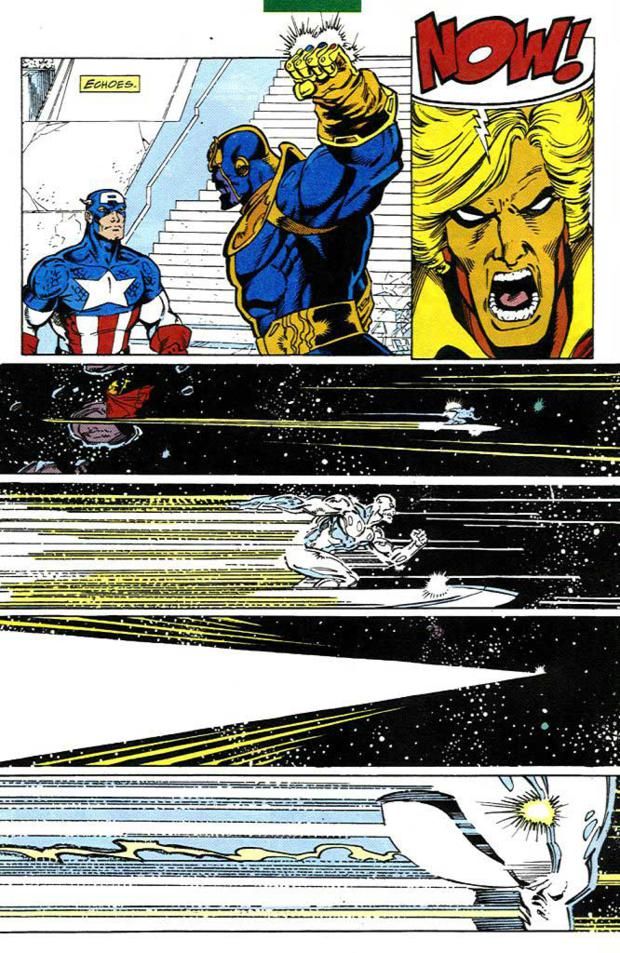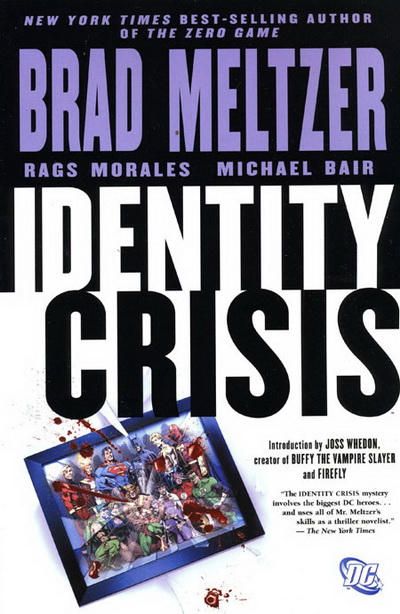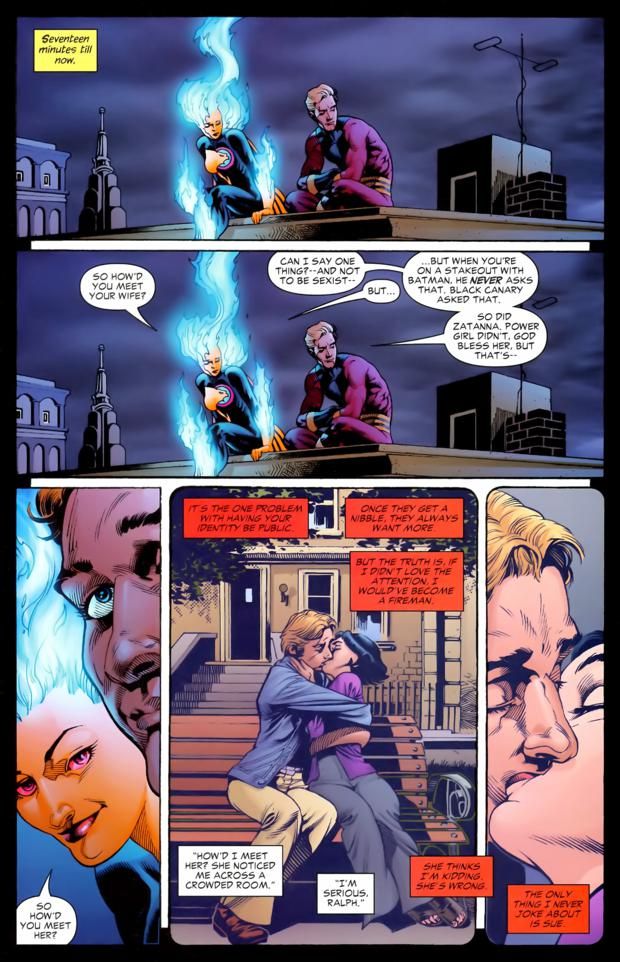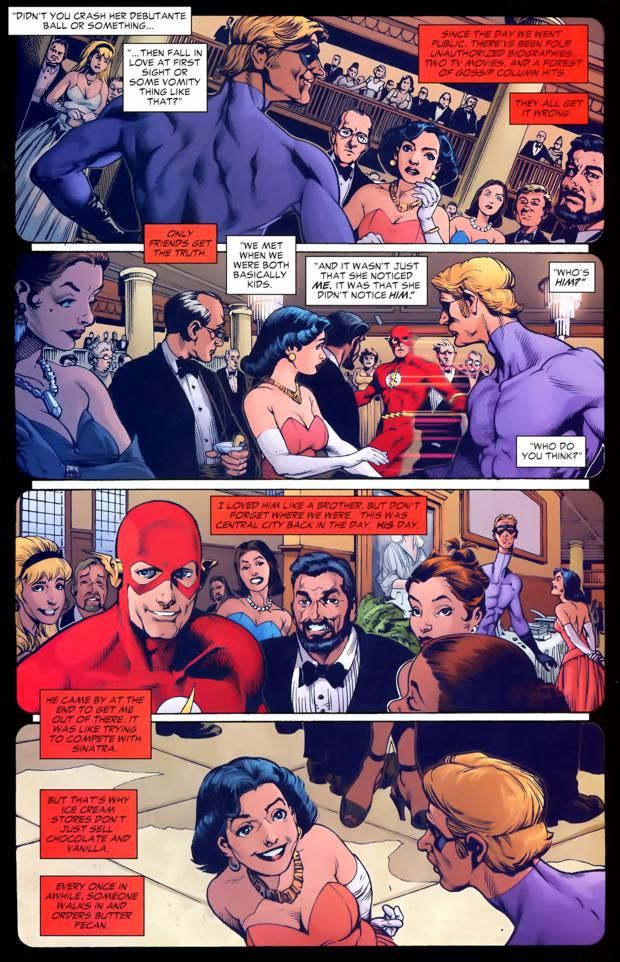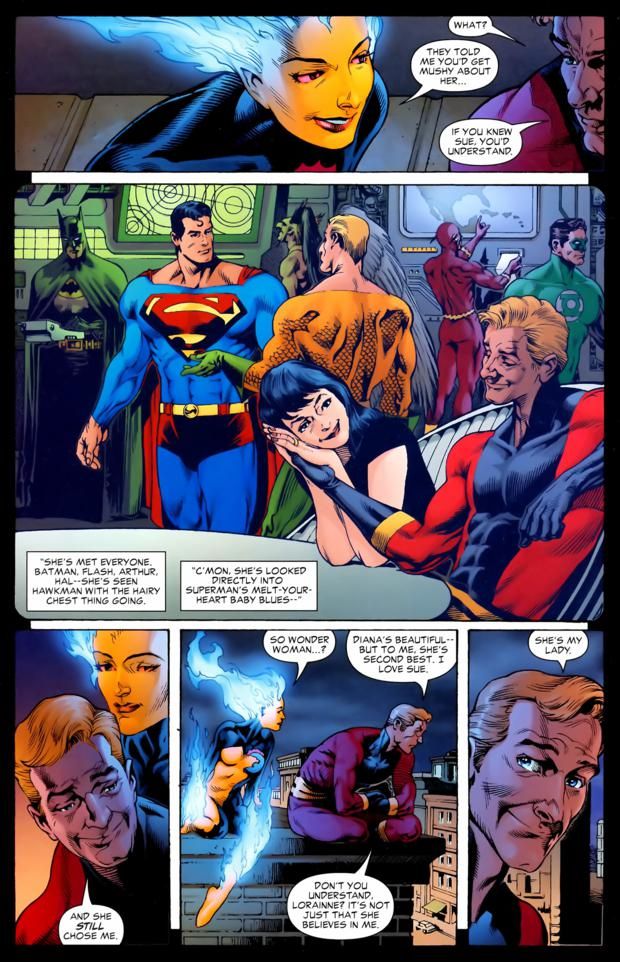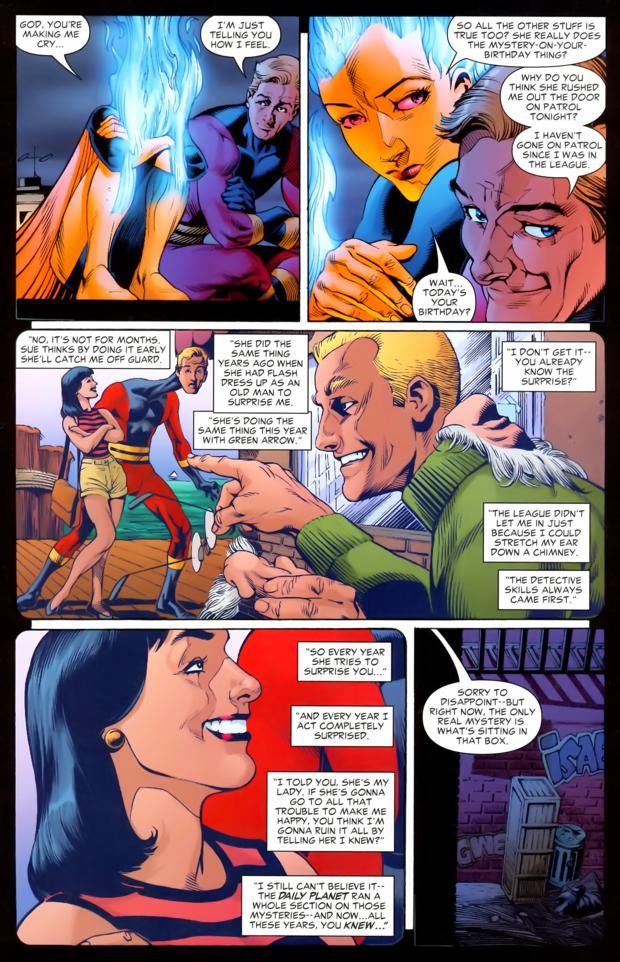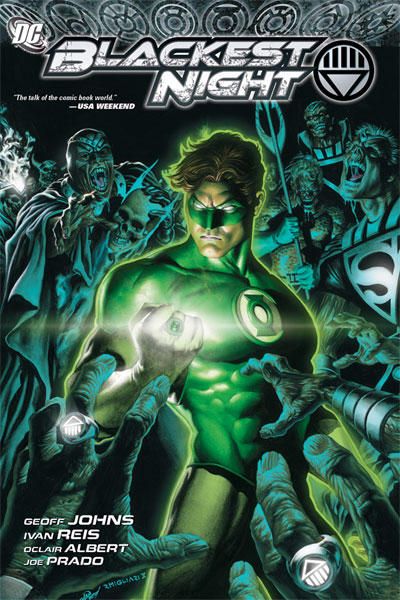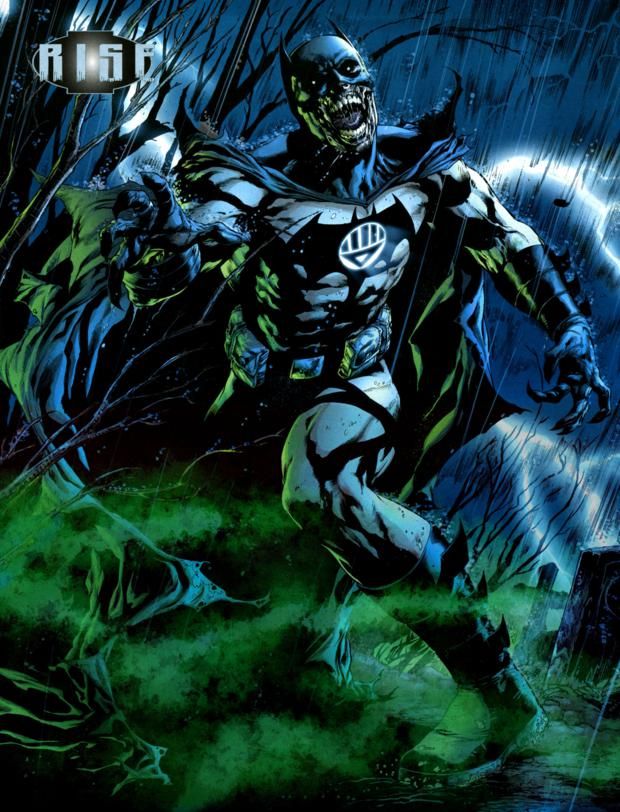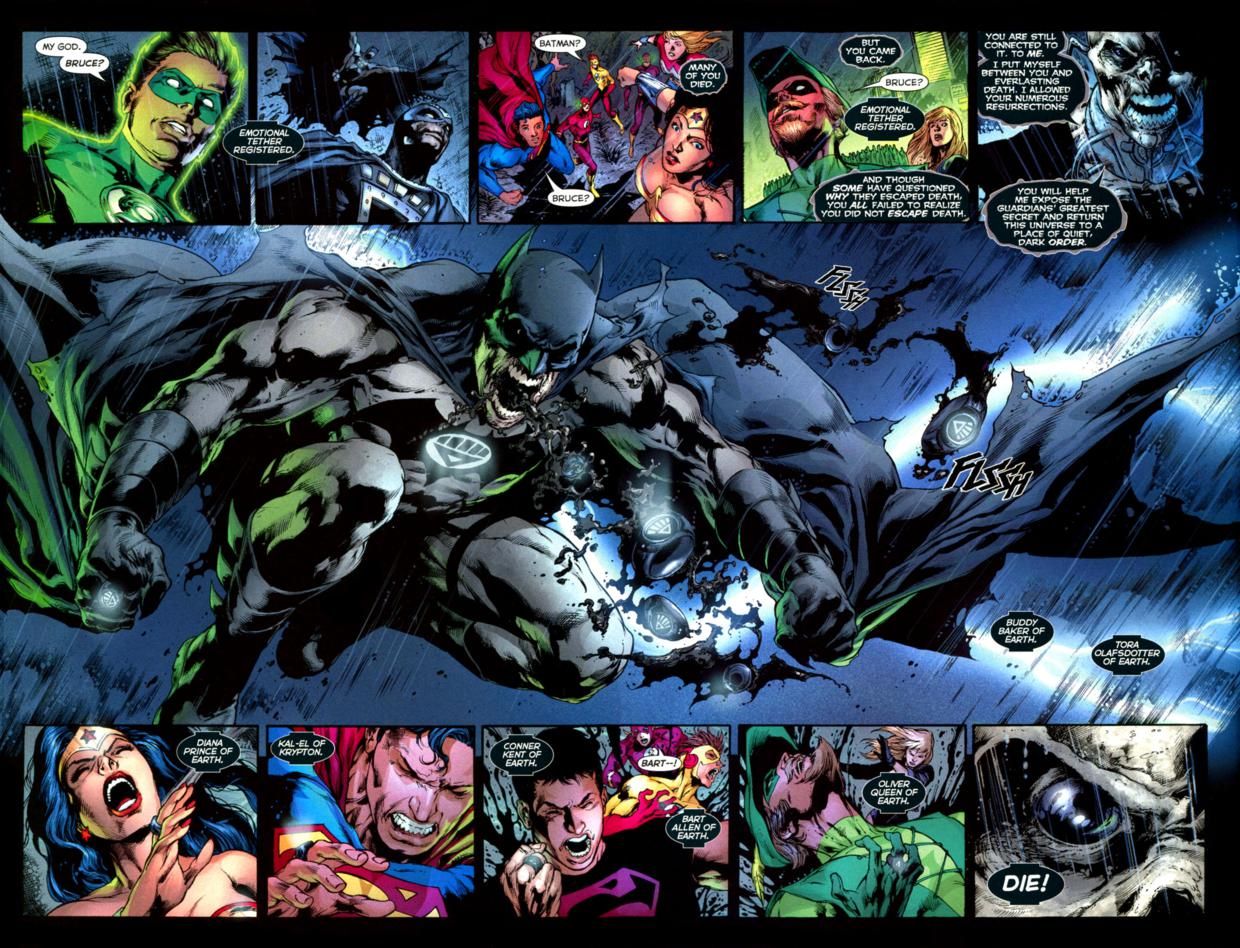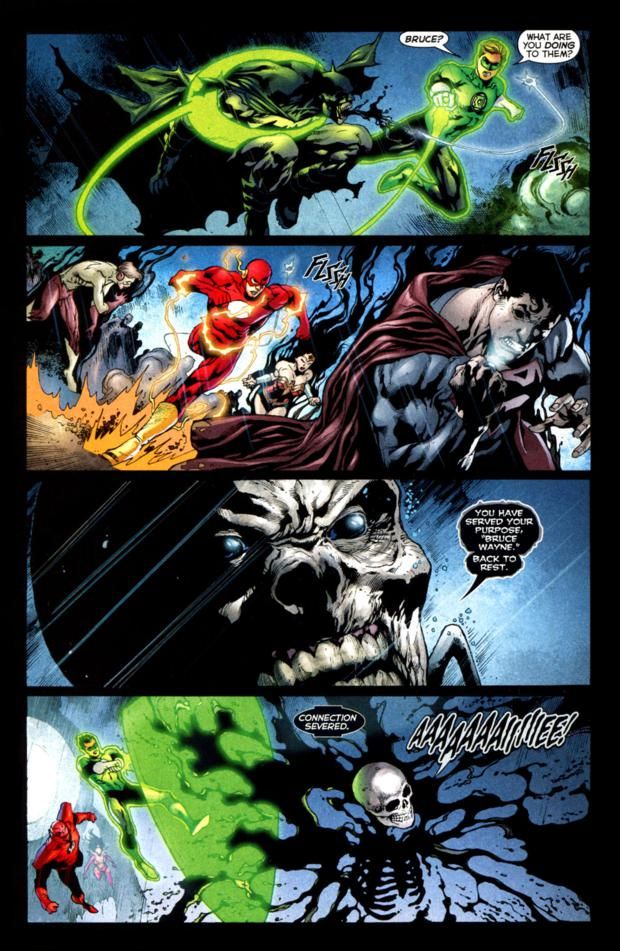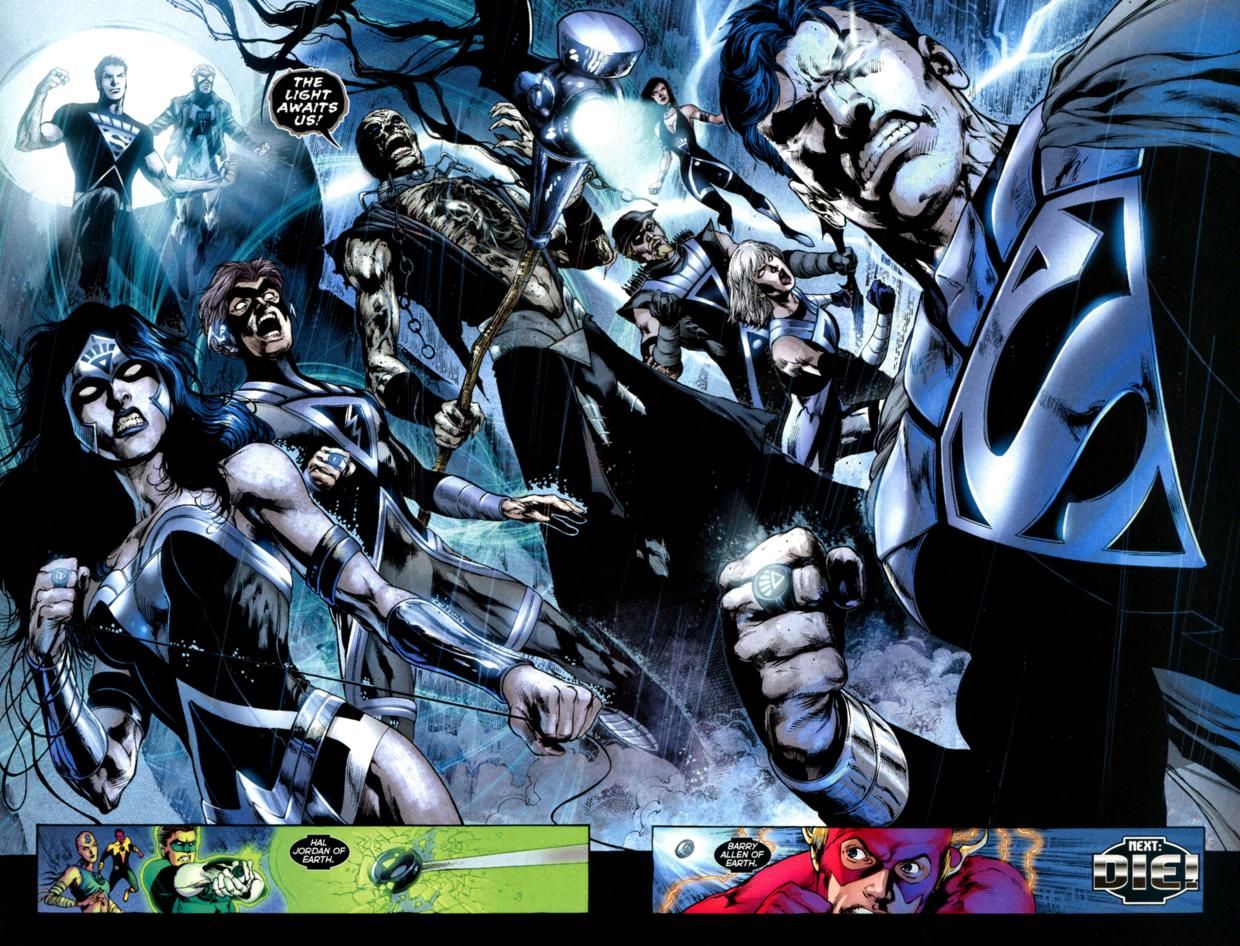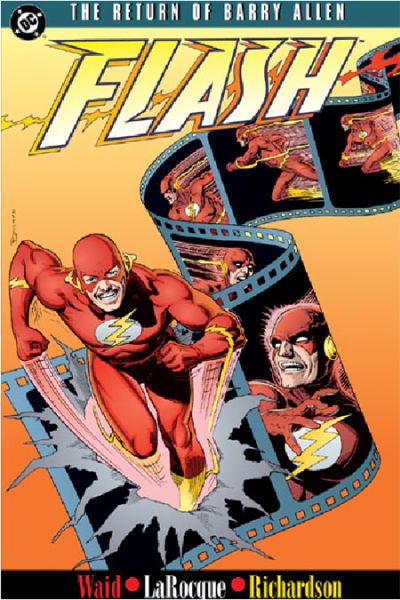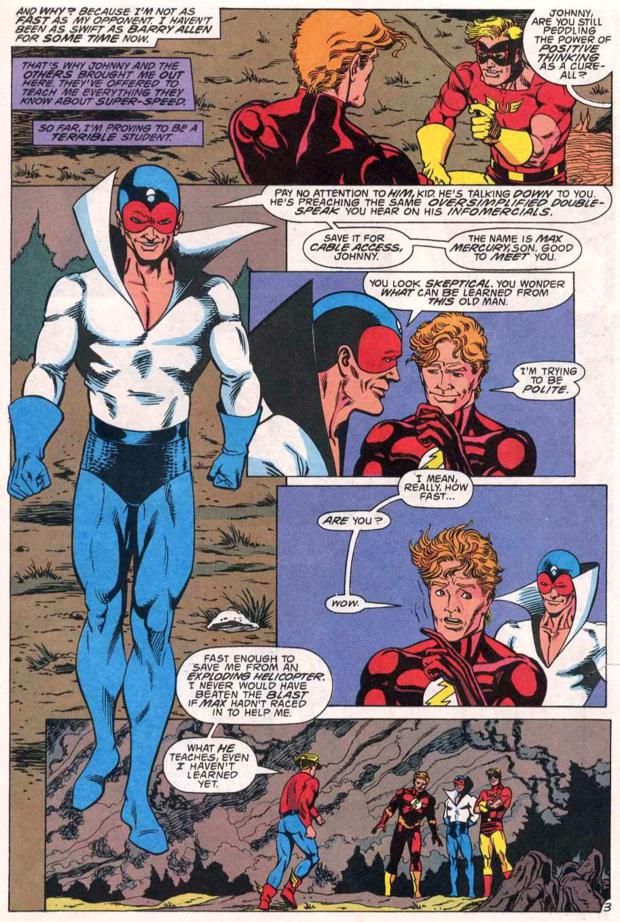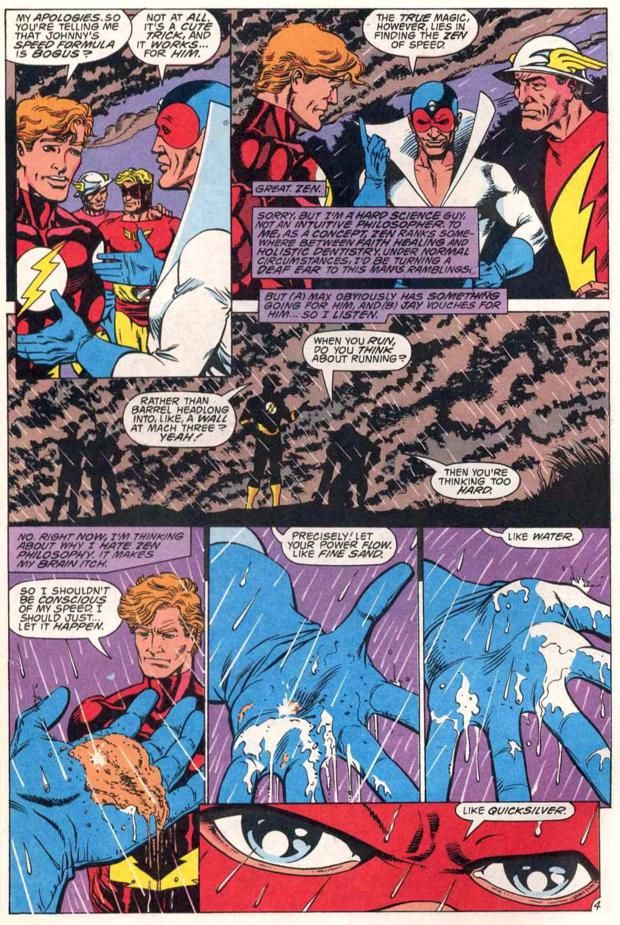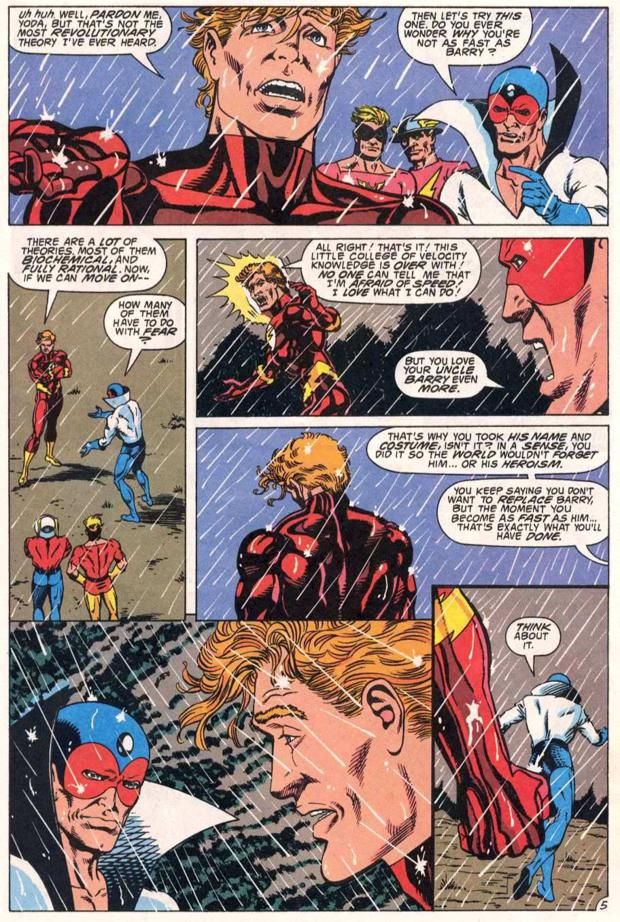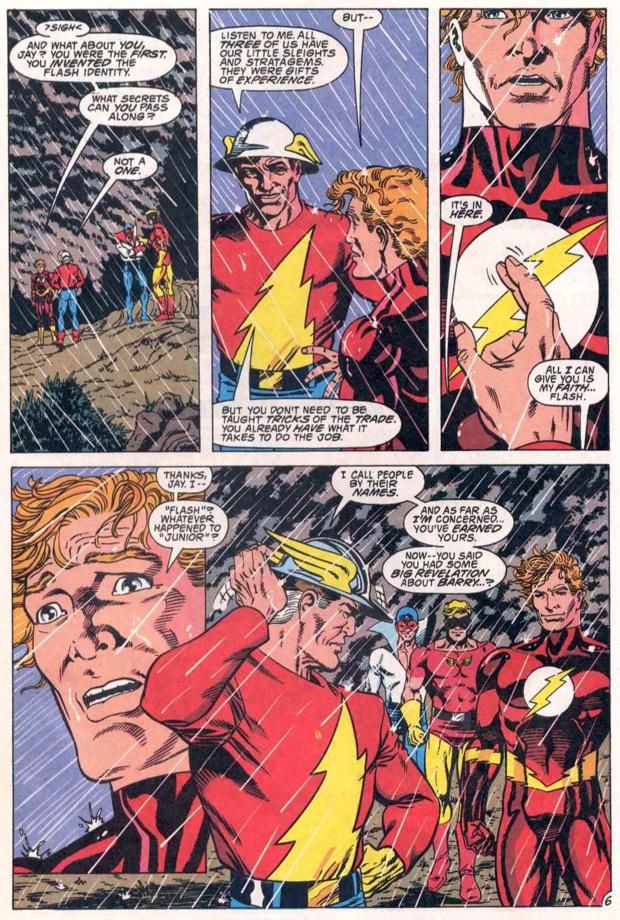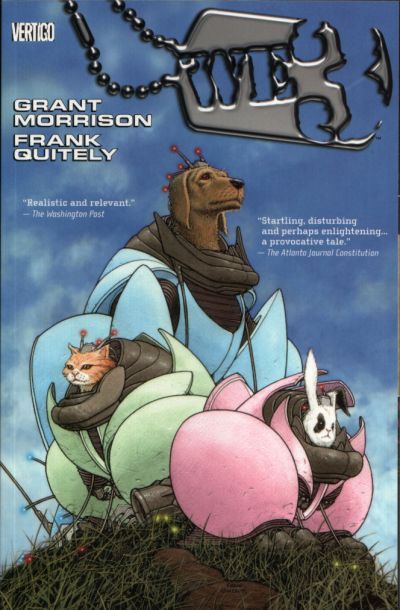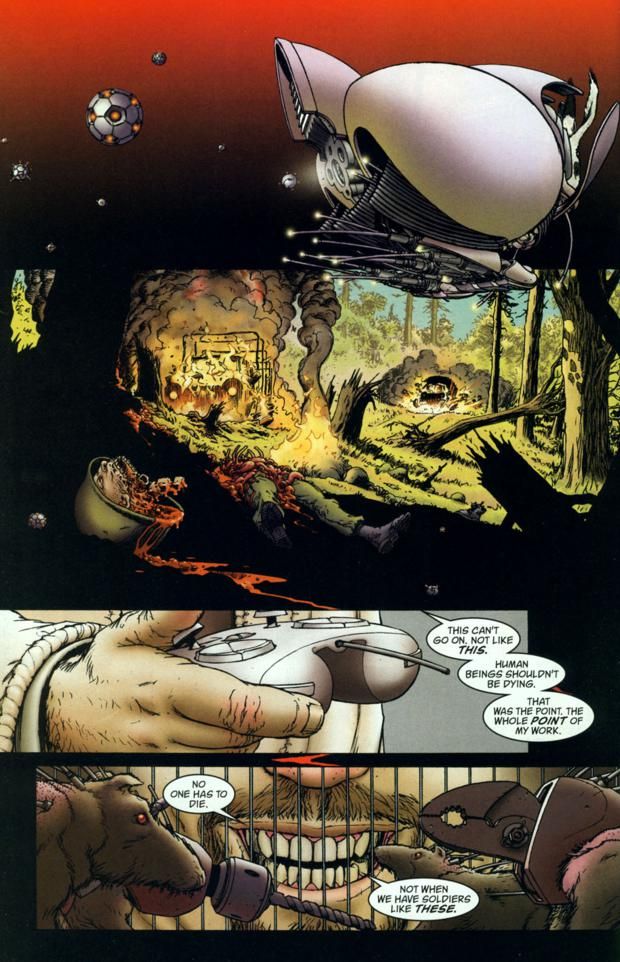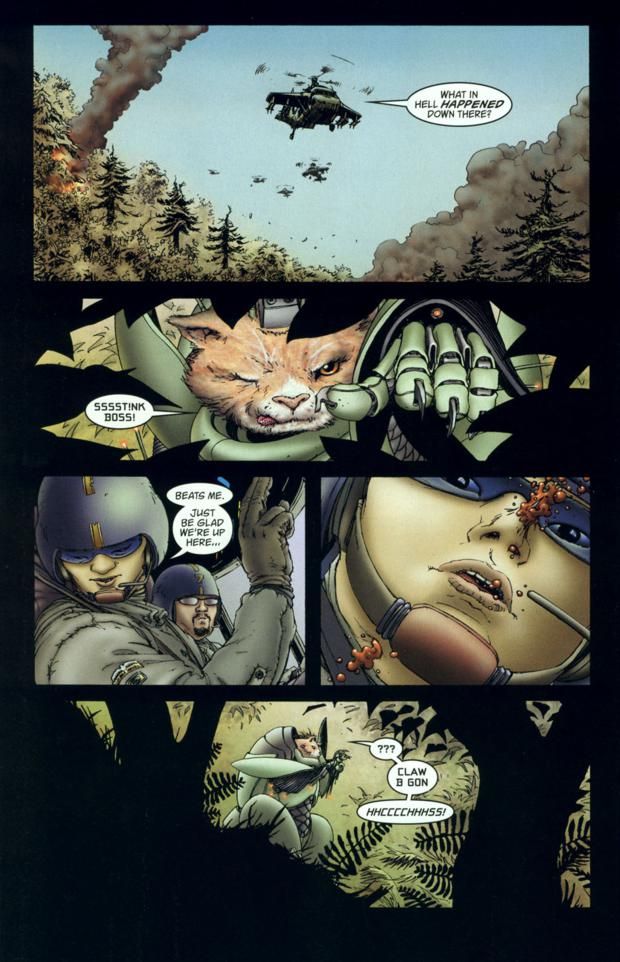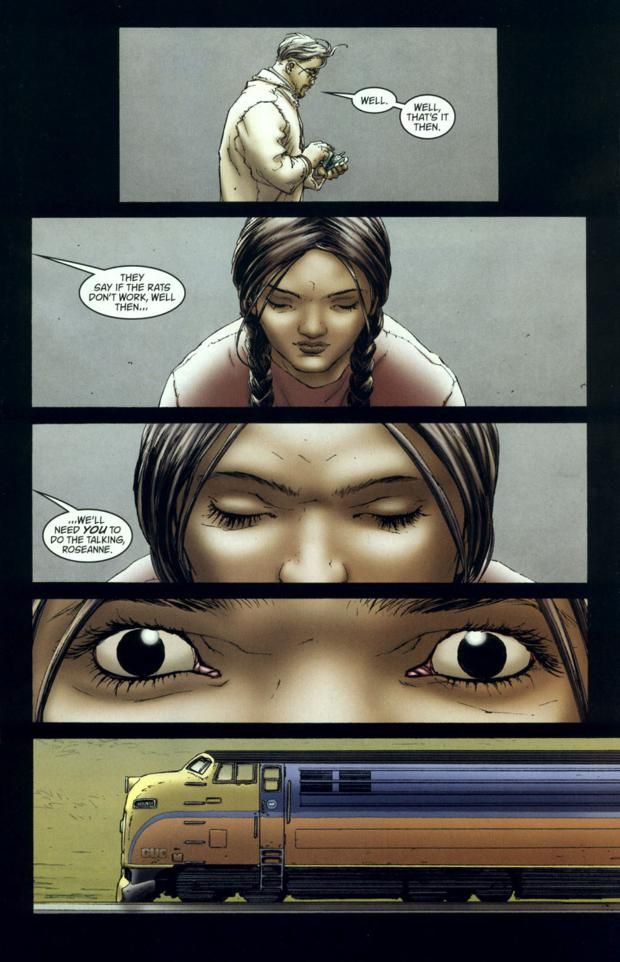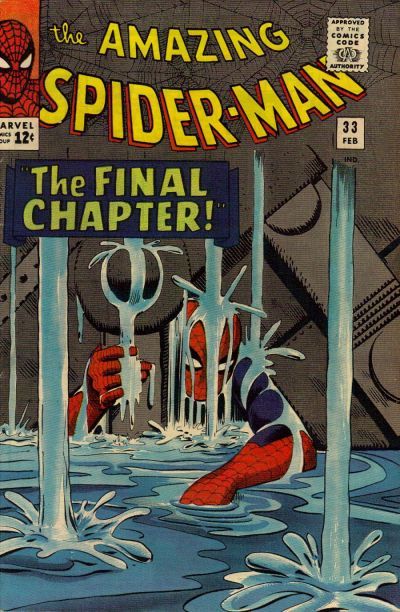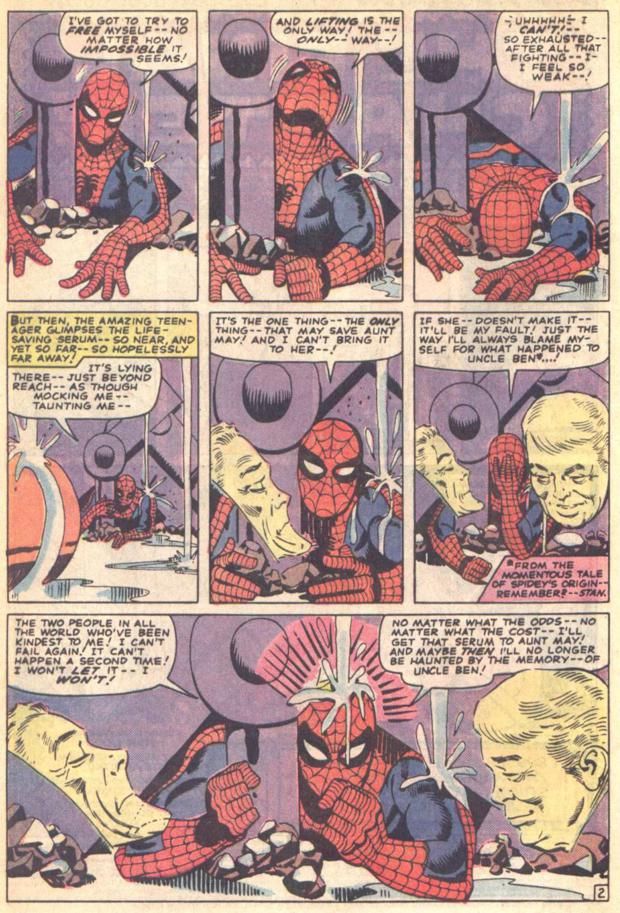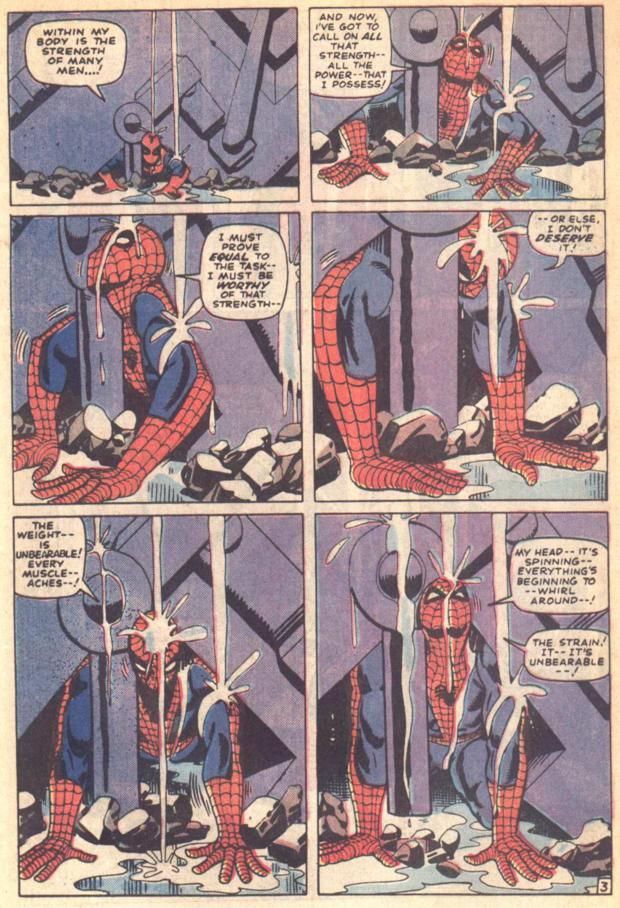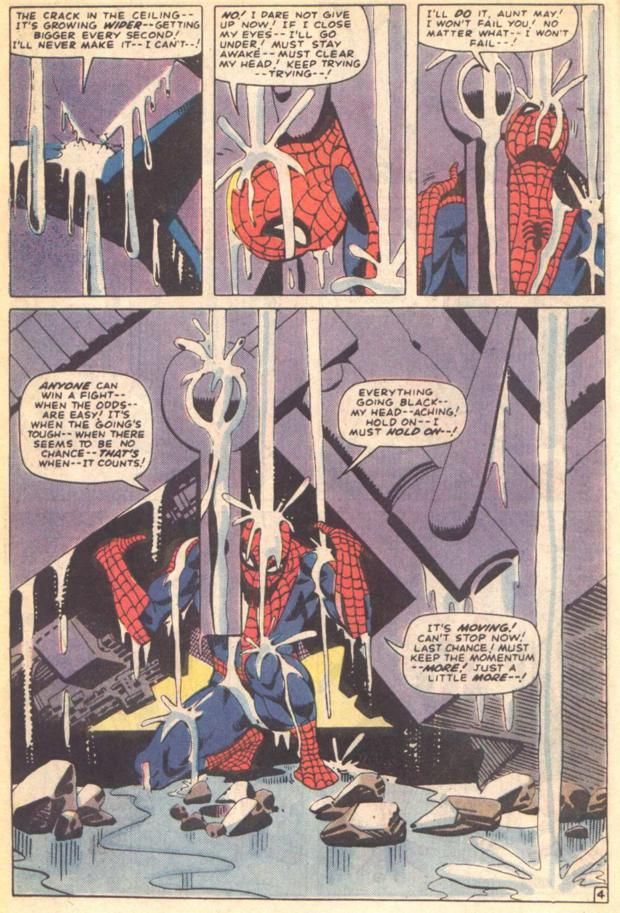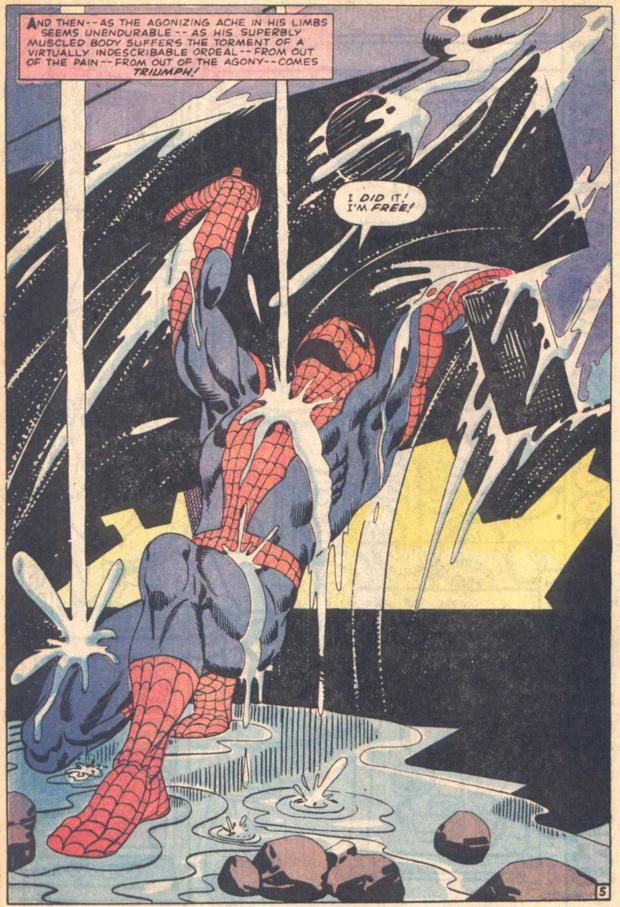Here are the next ten storylines on the countdown, as voted on by you, the readers!! Here is the master list of all storylines featured so far.
Okay, as usual, the votes are more bundled together at the bottom of the list and things open up as we go along. Eventually the results will be five a day, except today (also they'll be in smaller groups as we get to the very end)! Note, there may be some spoilers ahead! You are forewarned!
Enjoy!
NOTE: All of these storyline posts will be image intensive, so I'll be spreading them over multiple pages.
50. "High Society" by Dave Sim (Cerebus #26–50) – 203 points (7 first place votes)
A previous story in Cerebus ("Mind Games") was the real demarcation between "Cerebus: silly satire book" and "Cerebus: more serious satire book," but High Society was the most prominent storyline in establishing Cerebus as a more serious satire.
In this volume, our aardvark protagonist (for lack of a better descriptor for him) gets caught up in, well, high society. He is chosen to be a representative of the city-state of Palnu in the large city-state of Iest (where the comic would be set for the next six years or so). Much of the humor in the storyline is derived from Cerebus' seeming obliviousness to the standard tropes of high society. In a lot of ways, it is similar to the great Jerzy Kosi?ski screenplay, Being There, only Cerebus is certainly not an innocent - he just views things in a more mercenary fashion than most, and fails to play political games, although he is certainly willing to try.
He is latched on to by Astoria, the ex of Lord Julius (the head of Palnu), and she uses Cerebus' charisma as her own, and uses him to further her agenda, and in the process, makes him a popular political figure. As Cerebus' political ambitions broaden, the book takes an almost frantic nature as Sim makes the book much like an election story - you really begin to care if Cerebus' campaign will work.
At the same time, though, there are plenty of wacky gags, too (Sim couldn't divest himself of the early Cerebus stories TOO much, I suppose), including this roach who is manipulated into becoming Moon Roach, a parody of Moon Knight.
When the dust is settled, Cerebus is a changed aardvark, and he is quite ready for the next storyline, Church and State.
Honestly, while there would be some confusion at the start, I think I would probably recommend beginning reading Cerebus with this volume and skipping Volume 1. The book improved THAT much with this story.
49. "The Surtur Saga" by Walter Simonson (Thor #349-353) – 213 points (3 first place votes)
All throughout the early issues of Walt Simonson's run on Thor, we keep seeing someone (seemingly a blacksmith) forging a sword. Every time the sword is clanged on to continue the forging, we see a big "DOOM!" sound effect, showing that whatever this sword is, it is bad news for Thor. This continues for a number of issues (always for one page per issue) until slowly we learn that it is the gigantic demon Surtur, and we see that he is raising an army of dark elves to attack Asgard.
And again, we learn this slowly but surely over a number of issues, one page per issue.
Finally, in Thor #349, Surtur shows up on Asgard, and so begins an amazingly epic battle that involves Earth AND Asgard, and ends up ultimately with Odin, Thor and Loki being forced to team-up against their common foe, Surtur.
The defeat of Surtur would also result in a major status quo change in the Thor title, and one of the coolest last pages of the 1980s.
Simonson's art was extremely powerful throughout the story, adding the dynamic grand quality that the epic battles required.
And it's impressive as all heck that Surtur's attack begins in #349, but it doesn't feel dragged out, due to a whole ton of other little attacks and obstacles in between.
48. "Doll's House" by Neil Gaiman, Mike Dringenberg, Malcolm Jones III, Chris Bachalo, Michael Zulli and Steve Parkhouse (Sandman Vol. 2 #9-16) – 216 points (3 first place votes)
It's kind of funny. Each time I go to write about these Neil Gaiman Sandman storylines I find myself marveling in each arc at how well Gaiman is able to balance such disparate plots all within one cohesive tale. But then it occurs to me that perhaps this is not really an aberration to be pointed out but rather just a standard that Gaiman lives up to over and over again.
Anyhow, the main plot of this story is that a young woman Rose Walker finds herself at the center of a sort of dream vortex. Morpheus might be forced to destroy her to save reality. What he doesn't realize, though, is that Rose's current circumstances might very well be part of a sinister plot against Morpheus, in the sense that Morpheus' devotion to his duty is SO strong that anyone who knows him would know he'd feel obligated to destroy Rose. Thus, that knowledge could be turned against him. But who knows Morpheus that well? That's a mystery that you'll have to read the book to discover.
Other notable parts of this storyline is the introduction of the immortal Hob Gadling in a powerful one-off examination of what it would really be like if a guy just could not die. Hob would soon become one of the most popular recurring characters in Sandman.
In addition, we see Gaiman tie in the 1970s Jack Kirby Sandman revamp with the current Sandman series, we see the introduction of a number of characters who live in the same boarding house as Rose (these characters all become much more important in later stories) and we meet another interesting supporting characters, an escaped nightmare named Corinthian, who has become a legend among serial killers. He attends a serial killer convention (that Rose accidentally ends up, as well) where Morpheus shows up and delivers some Spectre-level punishment on the serial killer scumbags...
Powerful stuff.
Interestingly enough, this was the FIRST Sandman story to be collected into a trade, coming out BEFORE the first arc (originally the trade included the one-off issue #8 that introduced Death. That issue is no longer included with A Doll's House in trades).
Go to the next page for #47-44...
47. "Ultron Unlimited" by Kurt Busiek, George Perez and Al Vey (Avengers #19-22) – 218 points (1 first place vote)
The concept of the storyline (written by Kurt Busiek and drawn by George Perez and Al Vey) is that Ultron IX has decided that he does not want to simply wipe out humans from Earth – he wants to repopulate the world with his own people: robots. He begins this attempt in horrific fashion as he enters the small European country of Slorenia and proceeds to slaughter the entire human population in three hours. He sends a message to the horrified public watching at home – do not come into this county or suffer the same fate.
Meanwhile, he has also kidnapped the Avengers that he considers "family" and intends to use their brainwaves to base his new world population of robots on, much like the way he earlier based his intended robot bride Jocasta on Wasp's brainwaves, the android Vision on the brainwaves of Wonder Man and the robot Alkhema on the brainwaves of Mockingbird.
It is during this story that we learn for the first time something that probably should have been evident to readers earlier (it's somewhat surprising it took decades until Busiek came up the concept), which is that Ultron's mind was based on the brainwaves of his creator, Hank Pym, who happens to be among the Avengers kidnapped by Ultron.
The Avengers ultimately decide to invade Slorenia, resulting in many interesting battles within the country as the small band of heroes seem to be overmatched by Ultron's apparently unending supply of robot drones (hence the "Unlimited" part of the story's title). During the course of this war, the Avengers have to face off against all the earlier Ultrons, each of whom was enough to fight them to a standstill in previous years.
Ultron is quite confident that his minions are more than enough to defeat the Avengers. That same confidence leads to one of the coolest dramatic entrances ever (and winner of a Wizard Award that year for Best Moment) when the Avengers burst into Ultron's lair, looking quite ragged, with Thor speaking for the entire team when he declares "Ultron, we would have words with thee!"
Very cool.
46. "Infinity Gauntlet" by Jim Starlin, George Perez, Ron Lim, Joe Rubinstein and a couple of other inkers (Infinity Gauntlet #1-6) – 223 points (1 first place vote)
The mad god Thanos devoted his entire life (and since he has been resurrected a few times, his entire after-life) to pleasing the love of his life – Death. When Death decides she needs a champion once again, she brings Thanos back to life. In an attempt to please her, Thanos goes on a quest for the Infinity Gems; the powerful items that seem to power the various Elders of the Universe.
After finally collecting all of the gems through various methods, Thanos brings them together to form the Infinity Gauntlet, a glove that, when worn, gives the user complete power over the universe. What Thanos does with the Gauntlet is the subject of the 1991 Marvel mini-series, “Infinity Gauntlet” by writer Jim Starlin and artists George Perez (issues #1-3) and Ron Lim (issues #4-6).
His first act, seen in the first issue, to impress Death is to kill half of the universe, which he does with a snap of the fingers. The remaining half of the universe, naturally, is not happy about this and sets about to try to stop Thanos. They are aided by a similarly resurrected Adam Warlock, who was Thanos' main nemesis back when they were both first alive.
Warlock helps organize an excursion of as many superheroes as they can gather (Doctor Doom, too) to attack Thanos at his fortress. Thanos, meanwhile, in another attempt to impress Death (as suggested to him by that wily devil, Mephisto) has used the Gauntlet to make himself fallible, so that the superhero army attacking him actually has a theoretical chance at defeating him.
The heroes leave in issue #3, and it is in #4 that the battle takes place. Thanos mows through the heroes like he's a hot knife and they're all sticks of butter. Cyclops is suffocated, Iron Man has his head torn off, Thor is turned to glass – it is not pretty. Finally, only Captain America remains, and in an impressive act of defiance, stands up to Thanos one on one. As Thanos gets ready to smite Cap, Warlock's real plan springs into action. The Silver Surfer swoops in at light speed to snatch the gauntlet away from Thanos. The whole attack was just a diversion so that Surfer could steal the gauntlet.
Only the Surfer misses.
You'll have to read the rest of the series to see what happens next, but suffice it to say that Starlin did a heck of a job on this crossover.
45. "Identity Crisis" by Brad Meltzer, Rags Morales and Michael Bair (Identity Crisis #1-7) – 230 points (2 first place votes)
Identity Crisis is a murder mystery, where the victim is the wife of a superhero, Elongated Man.
Sue Dibny, like her hero husband Ralph, was a public figure, so when she was murdered, it threw the whole superhero community into a frenzy - are THEIR loved ones at risk, too?
Before Sue dies, we get a touching tribute to their life together...
Very sad.
The death of Sue also caused a group of Justice Leaguers to reflect back on the last time they caught a super-villain messing with a loved one (Sue, actually) - they wiped his memory clean. So they figured that this villain might have remembered it, and since Sue's death possibly could have been caused by someone with this villain's powers, he became the most wanted villain on the planet.
Soon other loved ones of heroes are attacked (and some killed) and the mystery ratchets up, all the while contrasting with the loss of trust between some of the heroes when they learn what these Leaguers did in the past (not to mention a major battle when the fugitive villain hires Deathstroke the Terminator to protect him).
When the murderer is revealed - it is a shock to the system, to say the least.
Rags Morales and Michael Bair do a wonderful job with the facial expressions in this series, which is important because writer Brad Meltzer includes a good deal of emotional scenes.
This series has been one of the most influential series of the past 10 years for DC Comics, as a great many comics spun out of this one.
44. "Blackest Night" by Geoff Johns, Ivan Reis, Oclair Albert and Joe Prado (Blackest Night #1-8) – 234 points (3 first place votes)
In a lot of ways, Blackest Night is about the very artifices that make up comic book continuity, namely the false idea that comic book characters ever really die. In this storyline, a mysterious being shows up with Black Lantern Rings that can re-animate dead people.
Eventually, this approach even goes to those characters who were FORMERLY dead, as in this striking sequence in the fifth issue of the story...
Ultimately, though, this story is about the emotional spectrum, as Geoff Johns had slowly been building up a colored emotional spectrum in the pages of Green Lantern, from the rage of the Red Lanterns to the love of the Purple Lanterns. All of the colors of the emotional spectrum are going to be needed to take on Nekron and the mighty force of death.
This is a grand, sweeping epic storyline with bold and dramatic storytelling by Ivan Reis. This storyline also paid off years worth of Green Lantern stories in a way that both resolved the original stories but also set the stage for a lot more stories (most notably the follow-up maxi-series Brightest Day).
Go to the next page for #43-41...
43. "Return of Barry Allen" by Mark Waid, Greg Larocque and Roy Richardson (Flash Vol. 2 #73-79) - 235 points (5 first place votes)
Wally West is the Flash, the fastest man alive. In this classic Mark Waid tale, Wally's greatest dream turns into a nightmare as his uncle, Barry Allen, the Flash before Wally, returns to life. Only thing are not what they seem, and soon Wally is forced to collect a group of speedsters to confront Barry, who has returned...different. This storyline introduced Max Mercury to the title and really began the whole "Speed Force" idea that became such a major part of the title. In any event, while Wally gets help from the other speedsters, he soon learns that it ultimately comes down to him and his own fears of replacing his uncle to win the day. Waid planned it this way, to show that the only way for Wally to truly be accepted as a Flash by the fans is for Wally to accept HIMSELF as the Flash.
Greg LaRocque drew this arc, in his swan song on the title, after a long run as penciler.
42. "We3" by Grant Morrison and Frank Quitely (We3 #1-3) – 238 points (3 first place votes)
The description of We3 I always like to give to people is "Imagine a trio of high-tech cyber-assassins. And one is a dog, one is a kitty cat and one is a bunny rabbit."
That's where We3 begins, only, naturally, things change when the trio (named 1, 2 and 3, respectively) are about to be de-commissioned by the government. Their trainer won't allow it, and frees the group and then we have basically The Incredible Journey, only with a dog, a cat and a rabbit who have been turned into killing machines.
The group have varying personalities - the dog is the smartest, so he can sort of communicate with humans. The cat is next smartest, so she can only muster up stuff like "Boss stink!" The rabbit just can say when it wants to eat.
But together, they try to find their ephemeral "home."
It's a very touching story, and Frank Quitely's art is simply spectacular - it's a marvel to behold, really.
The story is only three issues long, but with the emotional punch it packs, you'd think you were following these characters for years, not three short months.
41. "If This Be My Destiny" by Steve Ditko and Stan Lee (Amazing Spider-Man #31-33) – 240 points (8 first place votes)
This storyline is particularly interesting in the fact that, right smack in the midst of it all, Gwen Stacy and Harry Osborn are introduced!
The story is set as Peter Parker is just beginning college - he hopes to be able to concentrate on his studies, but he soon learns that his Aunt May is deathly ill, likely due to a blood transfusion Peter gave her a number of issues ago (his blood being radioactive and all).
So Peter finds out a way of curing her, but he needs a special serum. Well, the problem is that a criminal known as the Master Planner ALSO wants the serum.
After a tussle, Spider-Man succeeds in securing the serum, but not before being trapped under a pile of heavy machinery in the Master Planner's underwater base - a base that has cracked, sending water from the river above ever so slowly into the room where Spider-Man is trapped. And if that weren't enough, the Master Planner's guards are outside the room should Spider-Man somehow escape!
How Spider-Man gets out of this mess is the thing of comic book legend, and that's just who the creative team was - Steve Ditko delivers what was basically his swan song on the title (he stuck around for a few more months, but clearly, this was the high water mark of his run - everything else was downhill from here until he left at #39, likely because he knew he was on the way out), and he goes out in style, with some of the most brilliantly designed pages of the Silver Age.
Stan Lee delivers the pathos along with Ditko's brilliant action sequences.
Peter's sense of responsibility never had such tangible evidence as this storyline - what he will do to save his Aunt is amazing, or maybe even spectacular!
Just like this storyline.

